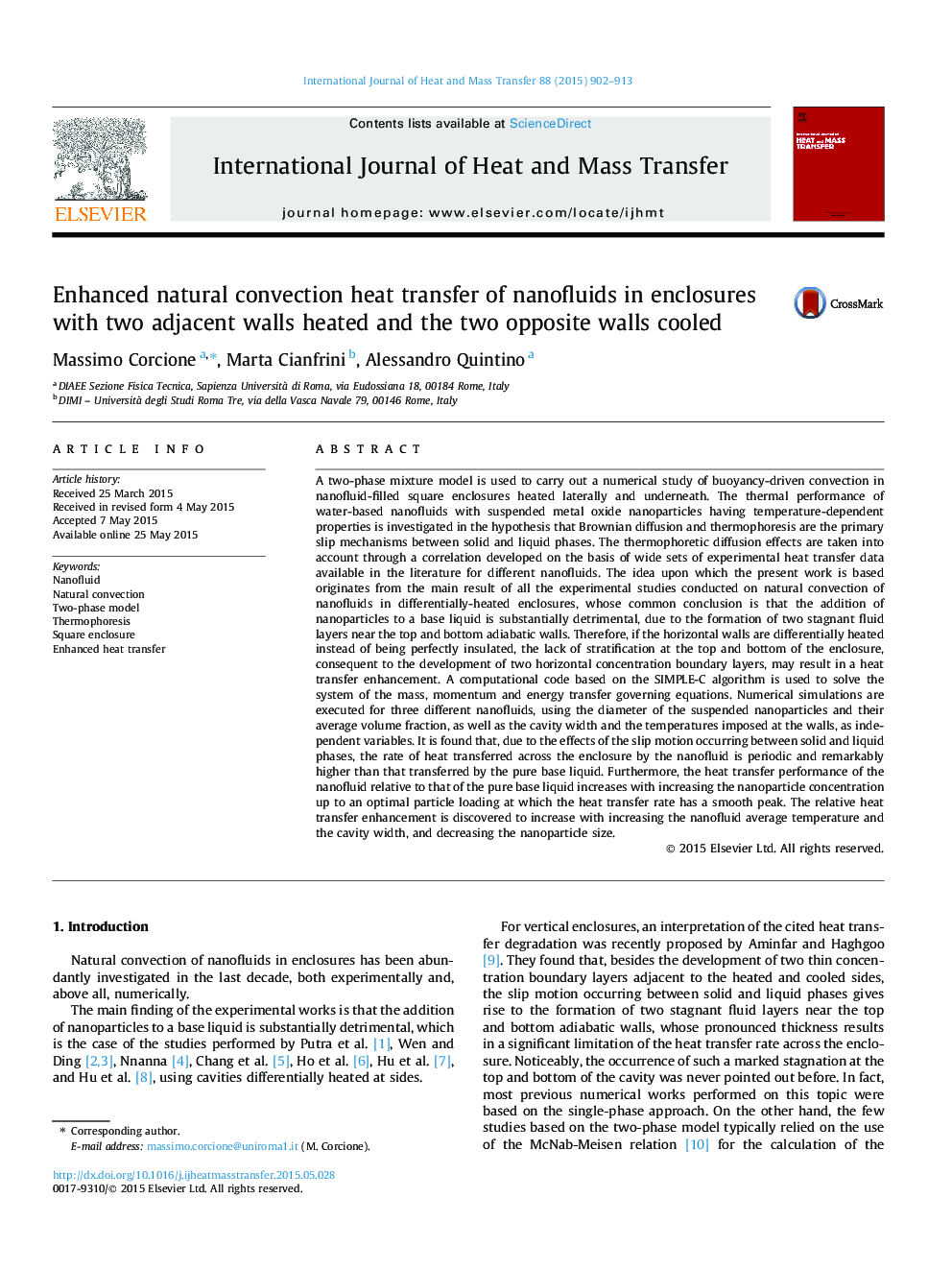| کد مقاله | کد نشریه | سال انتشار | مقاله انگلیسی | نسخه تمام متن |
|---|---|---|---|---|
| 657079 | 1458054 | 2015 | 12 صفحه PDF | دانلود رایگان |
عنوان انگلیسی مقاله ISI
Enhanced natural convection heat transfer of nanofluids in enclosures with two adjacent walls heated and the two opposite walls cooled
ترجمه فارسی عنوان
انتقال حرارتی طبیعی انتقال حرارت از نانوسیم ها در محفظه ها با دو دیواره مجاور گرم شده و دو دیواره مخلوط خنک شده
دانلود مقاله + سفارش ترجمه
دانلود مقاله ISI انگلیسی
رایگان برای ایرانیان
کلمات کلیدی
نانو سیال، پودر طبیعی مدل دو مرحلهای، ترموفورز، محوطه مربع، انتقال حرارت پیشرفته،
موضوعات مرتبط
مهندسی و علوم پایه
مهندسی شیمی
جریان سیال و فرایندهای انتقال
چکیده انگلیسی
A two-phase mixture model is used to carry out a numerical study of buoyancy-driven convection in nanofluid-filled square enclosures heated laterally and underneath. The thermal performance of water-based nanofluids with suspended metal oxide nanoparticles having temperature-dependent properties is investigated in the hypothesis that Brownian diffusion and thermophoresis are the primary slip mechanisms between solid and liquid phases. The thermophoretic diffusion effects are taken into account through a correlation developed on the basis of wide sets of experimental heat transfer data available in the literature for different nanofluids. The idea upon which the present work is based originates from the main result of all the experimental studies conducted on natural convection of nanofluids in differentially-heated enclosures, whose common conclusion is that the addition of nanoparticles to a base liquid is substantially detrimental, due to the formation of two stagnant fluid layers near the top and bottom adiabatic walls. Therefore, if the horizontal walls are differentially heated instead of being perfectly insulated, the lack of stratification at the top and bottom of the enclosure, consequent to the development of two horizontal concentration boundary layers, may result in a heat transfer enhancement. A computational code based on the SIMPLE-C algorithm is used to solve the system of the mass, momentum and energy transfer governing equations. Numerical simulations are executed for three different nanofluids, using the diameter of the suspended nanoparticles and their average volume fraction, as well as the cavity width and the temperatures imposed at the walls, as independent variables. It is found that, due to the effects of the slip motion occurring between solid and liquid phases, the rate of heat transferred across the enclosure by the nanofluid is periodic and remarkably higher than that transferred by the pure base liquid. Furthermore, the heat transfer performance of the nanofluid relative to that of the pure base liquid increases with increasing the nanoparticle concentration up to an optimal particle loading at which the heat transfer rate has a smooth peak. The relative heat transfer enhancement is discovered to increase with increasing the nanofluid average temperature and the cavity width, and decreasing the nanoparticle size.
ناشر
Database: Elsevier - ScienceDirect (ساینس دایرکت)
Journal: International Journal of Heat and Mass Transfer - Volume 88, September 2015, Pages 902-913
Journal: International Journal of Heat and Mass Transfer - Volume 88, September 2015, Pages 902-913
نویسندگان
Massimo Corcione, Marta Cianfrini, Alessandro Quintino,
